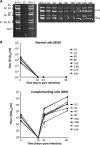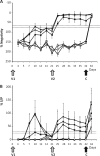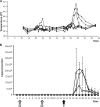Rapid generation of replication-deficient monovalent and multivalent vaccines for bluetongue virus: protection against virulent virus challenge in cattle and sheep
- PMID: 23824810
- PMCID: PMC3754119
- DOI: 10.1128/JVI.01514-13
Rapid generation of replication-deficient monovalent and multivalent vaccines for bluetongue virus: protection against virulent virus challenge in cattle and sheep
Abstract
Since 1998, 9 of the 26 serotypes of bluetongue virus (BTV) have spread throughout Europe, and serotype 8 has suddenly emerged in northern Europe, causing considerable economic losses, direct (mortality and morbidity) but also indirect, due to restriction in animal movements. Therefore, many new types of vaccines, particularly subunit vaccines, with improved safety and efficacy for a broad range of BTV serotypes are currently being developed by different laboratories. Here we exploited a reverse genetics-based replication-deficient BTV serotype 1 (BTV-1) (disabled infectious single cycle [DISC]) strain to generate a series of DISC vaccine strains. Cattle and sheep were vaccinated with these viruses either singly or in cocktail form as a multivalent vaccine candidate. All vaccinated animals were seroconverted and developed neutralizing antibody responses to their respective serotypes. After challenge with the virulent strains at 21 days postvaccination, vaccinated animals showed neither any clinical reaction nor viremia. Further, there was no interference with protection with a multivalent preparation of six distinct DISC viruses. These data indicate that a very-rapid-response vaccine could be developed based on which serotypes are circulating in the population at the time of an outbreak.
Figures






Similar articles
-
Replication-Deficient Particles: New Insights into the Next Generation of Bluetongue Virus Vaccines.J Virol. 2016 Dec 16;91(1):e01892-16. doi: 10.1128/JVI.01892-16. Print 2017 Jan 1. J Virol. 2016. PMID: 27795442 Free PMC article.
-
Generation of replication-defective virus-based vaccines that confer full protection in sheep against virulent bluetongue virus challenge.J Virol. 2011 Oct;85(19):10213-21. doi: 10.1128/JVI.05412-11. Epub 2011 Jul 27. J Virol. 2011. PMID: 21795358 Free PMC article.
-
Strong protection induced by an experimental DIVA subunit vaccine against bluetongue virus serotype 8 in cattle.Vaccine. 2014 Nov 20;32(49):6614-21. doi: 10.1016/j.vaccine.2014.09.066. Epub 2014 Oct 11. Vaccine. 2014. PMID: 25312275
-
Vaccines for bluetongue.Aust Vet J. 1996 Jun;73(6):207-10. doi: 10.1111/j.1751-0813.1996.tb10036.x. Aust Vet J. 1996. PMID: 8893989 Review.
-
Control of bluetongue in Europe.Vet Microbiol. 2013 Jul 26;165(1-2):33-7. doi: 10.1016/j.vetmic.2013.01.010. Epub 2013 Jan 29. Vet Microbiol. 2013. PMID: 23462519 Review.
Cited by
-
A review of experimental infections with bluetongue virus in the mammalian host.Virus Res. 2014 Mar;182:21-34. doi: 10.1016/j.virusres.2013.12.044. Epub 2014 Jan 24. Virus Res. 2014. PMID: 24462840 Free PMC article. Review.
-
The 13th International Double-Stranded RNA Virus Symposium, Houffalize, Belgium, 24 to 28 September 2018.J Virol. 2019 Feb 5;93(4):e01964-18. doi: 10.1128/JVI.01964-18. Print 2019 Feb 15. J Virol. 2019. PMID: 30723139 Free PMC article.
-
An updated review on bluetongue virus: epidemiology, pathobiology, and advances in diagnosis and control with special reference to India.Vet Q. 2020 Dec;40(1):258-321. doi: 10.1080/01652176.2020.1831708. Vet Q. 2020. PMID: 33003985 Free PMC article. Review.
-
Assembly of Replication-Incompetent African Horse Sickness Virus Particles: Rational Design of Vaccines for All Serotypes.J Virol. 2016 Jul 27;90(16):7405-7414. doi: 10.1128/JVI.00548-16. Print 2016 Aug 15. J Virol. 2016. PMID: 27279609 Free PMC article.
-
Recent Development of Ruminant Vaccine Against Viral Diseases.Front Vet Sci. 2021 Nov 3;8:697194. doi: 10.3389/fvets.2021.697194. eCollection 2021. Front Vet Sci. 2021. PMID: 34805327 Free PMC article. Review.
References
-
- Maan NS, Maan S, Belaganahalli MN, Ostlund EN, Johnson DJ, Nomikou K, Mertens PP. 2012. Identification and differentiation of the twenty six bluetongue virus serotypes by RT-PCR amplification of the serotype-specific genome segment 2. PLoS One 7:e32601.10.1371/journal.pone.0032601 - DOI - PMC - PubMed
-
- Roy P, Marshall JJ, French TJ. 1990. Structure of the bluetongue virus genome and its encoded proteins. Curr. Top. Microbiol. Immunol. 162:43–87 - PubMed
-
- Veronesi E, Darpel KE, Hamblin C, Carpenter S, Takamatsu HH, Anthony SJ, Elliott H, Mertens PP, Mellor PS. 2010. Viraemia and clinical disease in Dorset Poll sheep following vaccination with live attenuated bluetongue virus vaccines serotypes 16 and 4. Vaccine 28:1397–1403 - PubMed
-
- Batten CA, Maan S, Shaw AE, Maan NS, Mertens PP. 2008. A European field strain of bluetongue virus derived from two parental vaccine strains by genome segment reassortment. Virus Res. 137:56–63 - PubMed
-
- Boone JD, Balasuriya UB, Karaca K, Audonnet JC, Yao J, He L, Nordgren R, Monaco F, Savini G, Gardner IA, Maclachlan NJ. 2007. Recombinant canarypox virus vaccine co-expressing genes encoding the VP2 and VP5 outer capsid proteins of bluetongue virus induces high level protection in sheep. Vaccine 25:672–678 - PubMed
Publication types
MeSH terms
Substances
Grants and funding
LinkOut - more resources
Full Text Sources
Other Literature Sources

